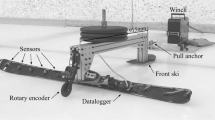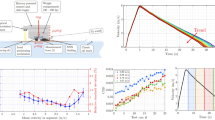Abstract
While many studies have documented the dynamic behaviour of skis, similar studies for snowboards have been rare. Characteristics such as board stiffness and damping are acknowledged to be linked to performance, but a quantitative determination of corresponding natural frequencies and damping ratios has to date not been published. The present work uses laboratory, computational and field studies to develop and document an in-depth understanding and quantification of snowboard dynamics. In particular, laboratory tests are used to determine the first three bending and first two torsional natural frequencies and modal damping ratios for eight snowboards from two manufacturers. Computer models are developed using the software packages Pro/ENGINEER and Pro/MECHANICA that accurately reproduce the experimentally measured natural frequencies and that facilitate visualization of mode shapes. Field tests are discussed that provide insights into the strains and accelerations experienced by snowboards while subject to turns, stops and jumps. Quantitative results are shown to correlate well with qualitative descriptions offered by manufacturers and riders. Medium-quality boards designed for beginner riders and characterized as ‘soft’ have lower natural frequencies and larger damping ratios than similar boards designed for advanced riders and characterized as ‘stiff.’ Moreover, boards designed for advanced riders and characterized as ‘high-quality’ have natural frequencies higher than ‘medium-quality’ boards while still exhibiting high damping ratios.
Similar content being viewed by others
References
ASTM (1995)Standard Terminology Relating to Snowboarding. ASTM Designation: F1107–95, American Society for Testing and Materials, 100 Barr Harbor Dr., West Conshohocken, PA, USA.
Dosch, J.J. (date unknown)Piezoelectric strain sensor. Unpublished technical report, PCB Piezotronics Inc., 3425 Walden Ave., Depew, NY, USA.
Ewins, D.J. (2000)Modal Testing: Theory, Practice and Application, New York, John Wiley and Sons.
Lind, D. & Sanders, S.P. (1996)The Physics of Skiing: Skiing at the Triple Point, New York, Springer-Verlag.
Michaud, J. & Duncumb, I. (1999)Physics of a snowboard carved turn. http://www.bomberonline.com/ Bomber_Files/Articles/JackM8/jackm8.html.
Nordt, A.A., Springer, G.S. & Kollár, L.P. (1999a) Computing the mechanical properties of alpine skis.Sports Engineering,2, 65–84.
Nordt, A.A., Springer, G.S. & Kollár, L.P. (1999b) Simulation of a turn on alpine skis.Sports Engineering,2, 181–199.
PCB Piezotronics (date unknown)Extreme testing, supreme performance. Model 740A02 dynamic ICP piezoelectric strain sensor advertising flyer, PCB Piezotronics Inc., 3425 Walden Ave., Depew, NY, USA.
Piziali, R.L. & C.D. Mote, C.D., Jr. (1972) The snow ski as a dynamic system.ASME Journal of Dynamic Systems, Measurement and Control,94, 133–138.
Sutton, E.B. (2000) Better snowboards by design. ASME International Mechanical Engineering Congress and Exposition, 2000-IMECE/DE-18.
Swinson, D.B. (1994) Physics and snowboarding.The Physics Teacher,32, 530–534.
Author information
Authors and Affiliations
Corresponding author
Rights and permissions
About this article
Cite this article
Buffinton, K.W., Shooter, S.B., Thorpe, I.J. et al. Laboratory, computational and field studies of snowboard dynamics. Sports Eng 6, 129–137 (2003). https://doi.org/10.1007/BF02859890
Issue Date:
DOI: https://doi.org/10.1007/BF02859890




